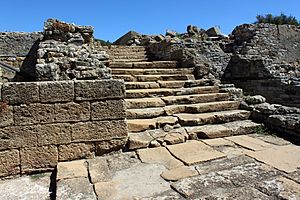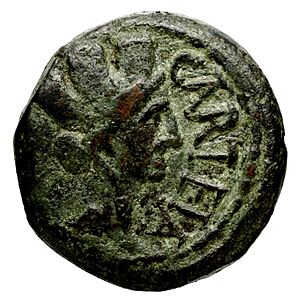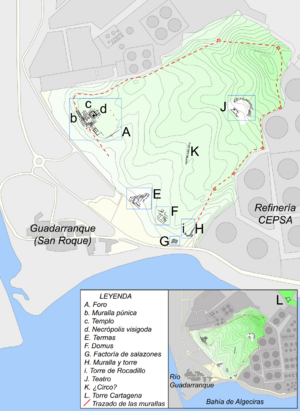Carteia facts for kids

Roman forum in Carteia.
|
|
| Location | San Roque, Province of Cádiz, Andalusia, Spain |
|---|---|
| Coordinates | 36°11′08″N 5°24′30″W / 36.185524°N 5.408301°W |
| Type | Settlement |
| History | |
| Founded | 940 BC |
| Cultures | Phoenician Carthaginian Roman |
| Site notes | |
| Condition | Partially excavated remains |
| Public access | Yes |
Carteia was an important ancient town in Spain. It was first built by the Phoenicians and later became a big Roman city. You can find its ruins at the top of the Bay of Gibraltar. This spot is near the modern town of San Roque. It's about halfway between Algeciras and Gibraltar.
People believe Carteia was founded around 940 BC. The Phoenicians, who were great traders, called it Kʿrt, meaning "city". This area was perfect for trade. It had lots of wood, grains, fruits, and metals like lead, iron, copper, and silver. They also made special dyes from shellfish, like the famous Tyrian purple. Some ancient writers even thought Carteia might have been the legendary city of Tartessos.
Because of its great location, Carteia was very important in the wars between Carthage and the Roman Republic. These wars happened in the 2nd and 3rd centuries BC. For example, in 206 BC, a Carthaginian admiral named Adherbal went to Carteia after losing a battle. Around 190 BC, the Romans took control of the town.
Contents
Carteia: A Roman City
In 171 BC, something special happened in Carteia. A group of people who were half-Roman and half-Spanish asked the Roman Senate for help. They were not considered full Roman citizens. The Senate decided to make Carteia a colonia. This was a special type of Roman town. About 4,000 of these Romano-Spanish people were given land there.
The people already living in Carteia could stay. Everyone in the town gained the right to marry Roman citizens and trade with Romans. This was a big deal! Carteia was the first city outside Italy to get these special rights, called the Latin Rights. It meant they were almost full Roman citizens. Other cities in Spain later got similar rights.
Life and Trade in Roman Carteia
The city, known as Colonia Libertinorum Carteia, thrived for over 580 years under Roman rule. It grew into a large city. Carteia was famous for exporting local wines. These wines were shipped in large clay jars called amphorae. They also made a popular fish sauce called garum.
Carteia had its own mint to make coins. It also had an amphitheatre for entertainment, temples for worship, and a busy port. The city played a role in Roman politics too. In 68 BC, the Roman general Pompey used Carteia as his base to fight pirates. Later, in 45 BC, Pompey's sons, Gnaeus and Sextus, gathered an army here. They were later defeated by Julius Caesar. Sextus escaped through Carteia's port.
Decline and Later History
We don't know much about Carteia's later Roman history. It seems the Visigoths attacked the city around 409 AD. By then, the city was likely already getting smaller. However, people continued to live there. Archaeologists have found parts of an early Christian church. There's also a Visigothic cemetery near some Roman temples.
During the 6th and 7th centuries, Carteia was part of the Byzantine Empire. In the 9th century, after the Umayyad conquest of Hispania, Islamic writings called the town Qartayanna. This was probably just a small village by then. Later, the Marinids built a tower nearby using stones from the old Roman walls. Today, this tower is called the Torre de Cartagena.
Rediscovering Carteia
A British Army officer named John Conduitt rediscovered the site of Carteia. He was stationed in Gibraltar between 1713 and 1717. He realized the ancient city was on a hill called El Rocadillo. An old book from 1845 described it: "corn grows where once Carteia flourished." It also mentioned finding coins, pottery, and glass there.
Conduitt shared his discovery with the Royal Society in London. He gave a talk about Carteia in 1717. Isaac Newton was even there! Newton was writing about ancient history and was very interested in Carteia. Conduitt later married Newton's niece, Catherine Barton.
What You Can See Today
In the early 1800s, people found broken pieces of marble and old building parts at Carteia. Some of the first excavations were done by the British in 1811–12. They found parts of a Roman floor and foundations of buildings.
Today, the area around Carteia is industrial. An oil refinery surrounds the site on three sides. The site was not protected until the 1960s. Sadly, some parts, like the cemetery and city gates, were lost to new buildings. But the main city area is saved and you can visit it!
You can still see many important structures. These include an old Carthaginian city gate and a large stone staircase. There's also a big temple, several houses, and Roman baths. The 16th-century Torre de Rocadillo is also there. Recent digs have found statues and other artifacts. The Carteia Archaeological Museum in San Roque displays many of these finds.
Images for kids
See also
 In Spanish: Carteia para niños
In Spanish: Carteia para niños





